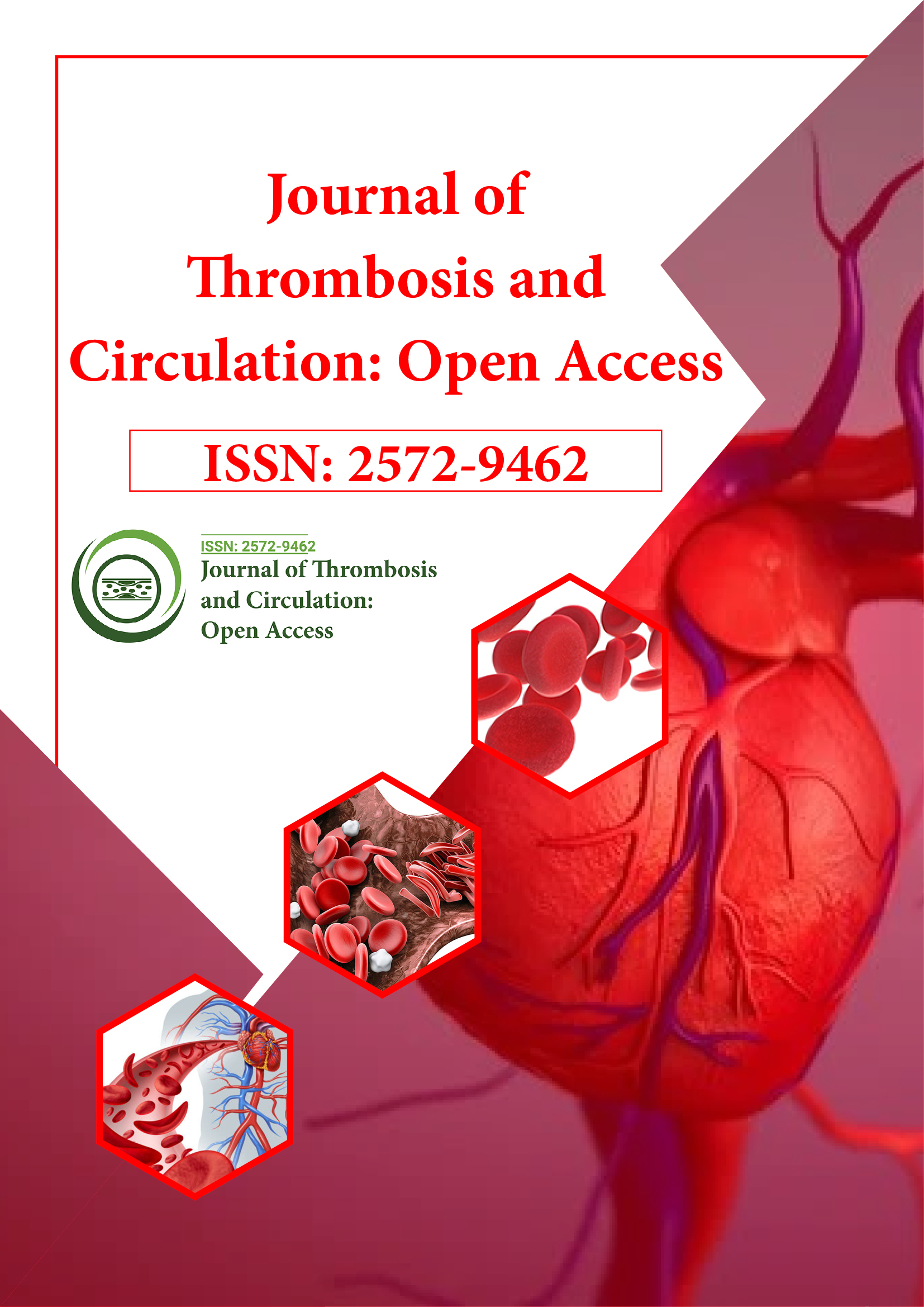Indexed In
- RefSeek
- Hamdard University
- EBSCO A-Z
- Publons
- Google Scholar
Useful Links
Share This Page
Journal Flyer

Open Access Journals
- Agri and Aquaculture
- Biochemistry
- Bioinformatics & Systems Biology
- Business & Management
- Chemistry
- Clinical Sciences
- Engineering
- Food & Nutrition
- General Science
- Genetics & Molecular Biology
- Immunology & Microbiology
- Medical Sciences
- Neuroscience & Psychology
- Nursing & Health Care
- Pharmaceutical Sciences
Editorial - (2021) Volume 7, Issue 4
Editorial Note on Stent Thrombosis
George Walker*Received: 02-Jul-2021 Published: 23-Jul-2021, DOI: 10.35248/2572-9462.21.7.161
Introduction
Stent apoplexy is characterized as a thrombotic impediment of a coronary stent. Stent apoplexy is a significant intricacy related with stent arrangement in percutaneous coronary mediation (PCI). Stent apoplexy has been related with high paces of grimness and mortality, frequently prompting occasions of heart passing or nonfatal myocardial localized necrosis (MI). Regularly contrasted with in-stent restenosis, which prompts angina sort side effects, stent apoplexy is commonly an intense cycle bringing about intense coronary condition (ACS). Different danger factors have been related with stent apoplexy, including a background marked by diabetes mellitus (DM), ACS, and decreased left ventricular discharge portion (LVEF). In view of the clinical situation, stent apoplexy might be suggestive or clinically quiet. Because of the idea of intense thrombotic impediment stent apoplexy regularly brings about ACS.
Huge randomized preliminaries and vault have distinguished patient/sore, procedural, or stent factors identified with stent apoplexy. Champion-phoenix preliminary distinguished NonST-rise myocardial localized necrosis (NSTEMI) and ST-height myocardial dead tissue (STEMI) at show, angiographic blood clot weight, and complete stent length as free indicators of intense stent apoplexy. A keenness preliminary uncovered diabetes mellitus, renal inadequacy, Duke danger score, last stent insignificant luminal measurement, preprocedural thienopyridine organization, benchmark hemoglobin, and degree of coronary course infection as free factors related with early stent apoplexy. In an intravascular ultrasound (IVUS) sub investigation of the Horizon AMI (intense myocardial localized necrosis) preliminary, the little cross-sectional space of under 5 mm, malposition of stent swaggers, plaque prolapse or projection, edge analyzation, and remaining stenosis assumed huge parts in foreseeing early stent apoplexy. Likewise, bifurcation stenting added to stent apoplexy. The Triton TIMI 38 preliminary showed that patients with STEMI are at higher danger of stent apoplexy paying little mind to stent type and that more powerful antiplatelet treatment, for example, prasugrel decreased that danger by half.
Stent apoplexy has been perceived from the early period of stent organization, with an occurrence as high as 16% in prior examinations. Fifteen to 30% of the patients with stent apoplexy pass on inside 30 days of the occasion. Acetylsalicylic corrosive (ASA), dipyridamole, coumadin, and dextran were attempted in the early stenting period to forestall the occasion. With the current act of double antiplatelet treatment and high-pressure swelling has fundamentally diminished rate to 0.7% in one year and about 0.2% to 0.6% the year after that. The rate is lower for elective percutaneous mediation (PCI) (0.3% to 0.5%) however as high as 3.4% for intense coronary condition. There has been generally speaking no huge distinction between the pace of stent apoplexy between uncovered metal stents and eluting drug stents. Just the circumstance of the occasion changes. The exposed metal stent will in general have an early occasion with a pinnacle of around 30 days contrasted with drug-eluting stents around 90 days to significantly later contingent upon the medication covered.
During angiography, a brief goal thrombectomy or angioplasty ought to be performed to reestablish the patency of the thrombosed vessel. Consistence and medication obstruction ought to be assessed. More strong antiplatelet treatment ought to be thought of, for instance, prasugrel or ticagrelor. The current suggestion is to proceed the double antiplatelet drug treatment for one year after drug-eluting stent situation and something like one month following exposed metal stent. The stent ought to be evaluated with either intravascular ultrasound (IVUS) or optical intelligence tomography (OCT) to decide stent juxtaposition, development, and the presence of edge analyzations. Enhancement of stent organization with proper proposition and treatment of edge analyzations with extra stents are basic to forestall rehash stent apoplexy. Extra stent implantation ought to be stayed away from if conceivable in light of the fact that every millimeter of the stent expands the likelihood of stent apoplexy.
Stent apoplexy is a significant entanglement related with stent position in PCI. Intricacies related with untreated stent apoplexy incorporate demise, myocardial localized necrosis, and cardiogenic shock. Entanglements identified with the treatment of stent apoplexy are like that of PCI. These incorporate however are not restricted to wounding, hematoma, pseudo aneurysm, retroperitoneal discharge, arrhythmia, contrast-initiated nephropathy, clots arrangement, contamination, ischemic stroke, and myocardial dead tissue.
Citation: Walker G (2021) Editorial Note on Stent Thrombosis J Thrombo Cir. 7:161. 10.35248/2572-9462.7.161.
Copyright: �?�©2021 Walker G. This is an open-access article distributed under the terms of the Creative Commons Attribution License, which permits unrestricted use, distribution, and reproduction in any medium, provided the original author and source are credited.
